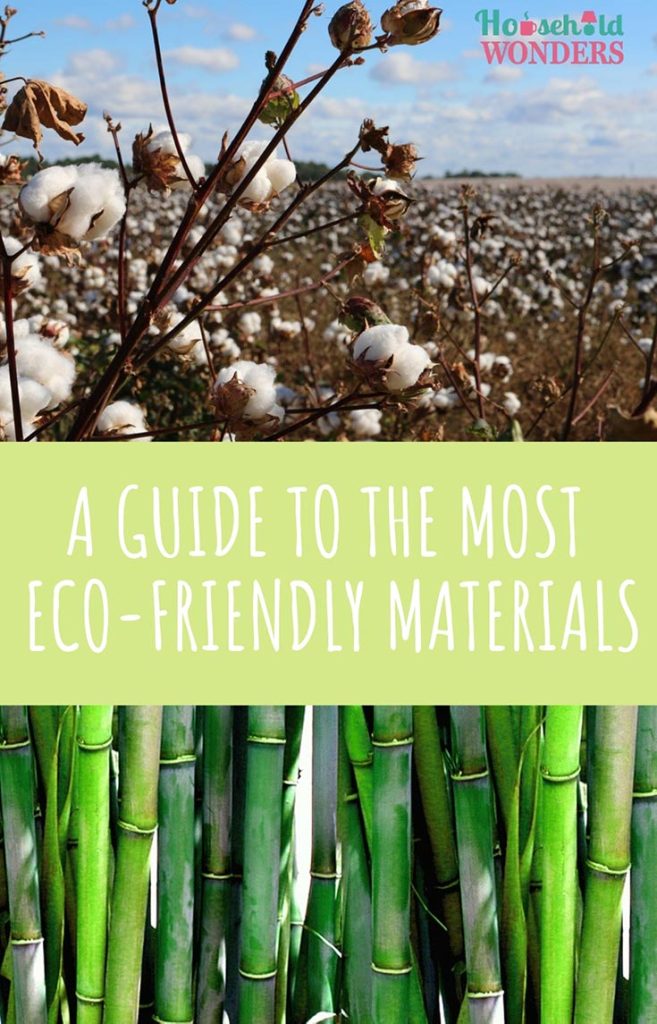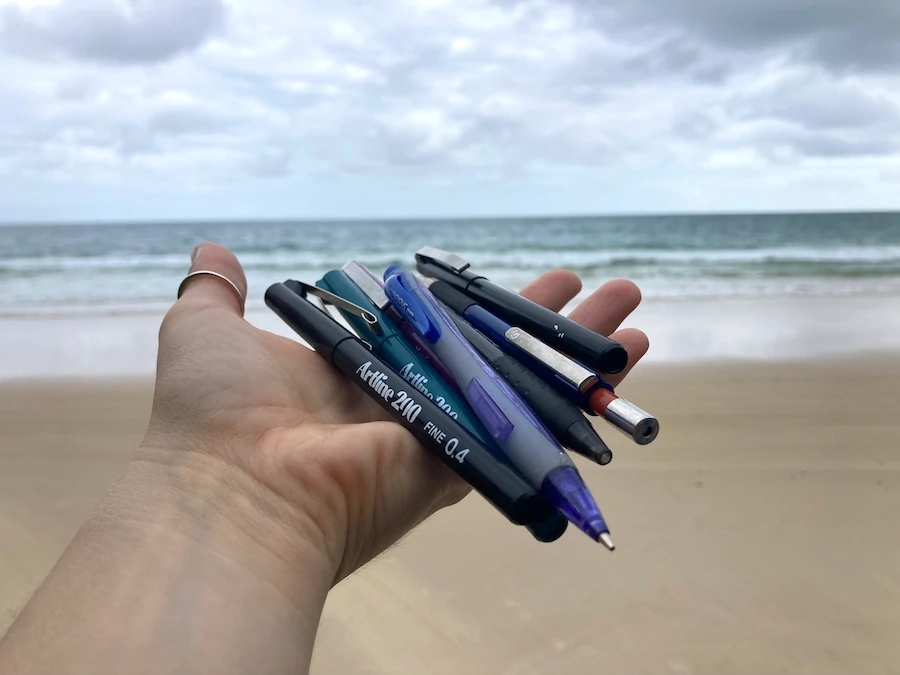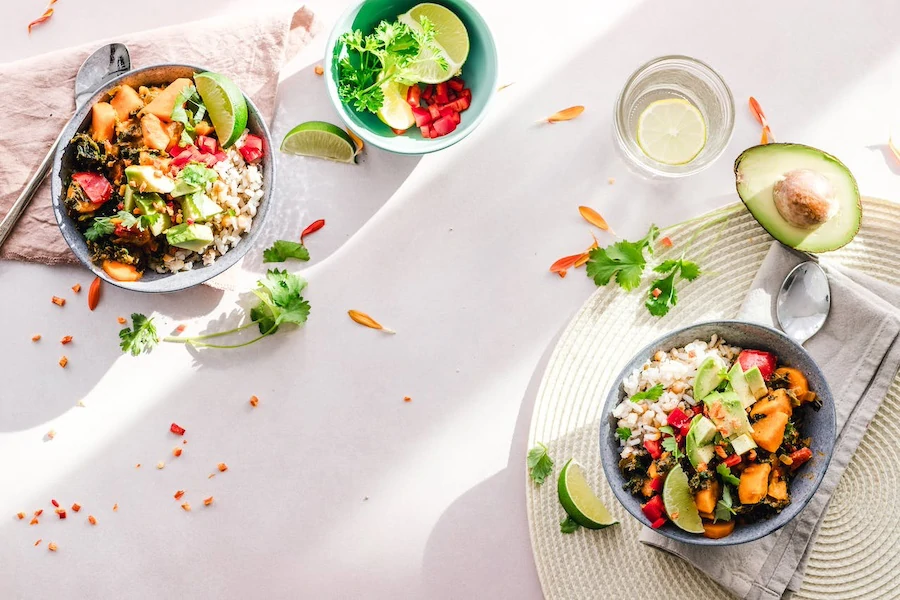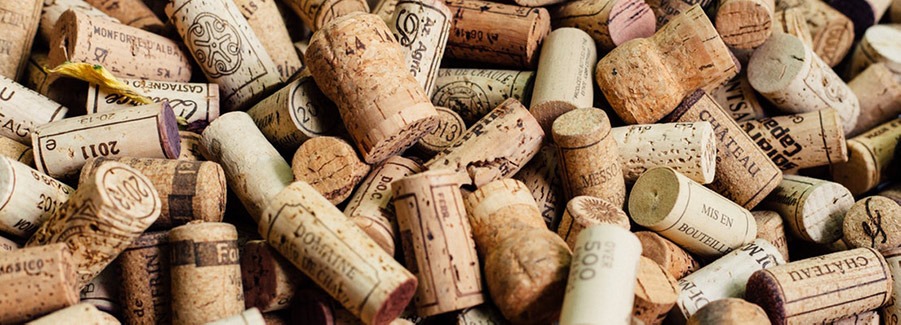
If you are looking for eco-friendly materials, there are many options you have. With many brands marketing their materials as sustainable and renewable resources, I always wonder which materials are the most eco-friendly.
Eco-friendly is a material that is not harmful to the environment. I’ve done some research and created a handy reference guide to the most eco-friendly materials that are available.
The Most Eco-Friendly Materials
1. Bamboo Fiber
Bamboo is considered one of the most renewable resources on the planet due to its ability to rapidly grow in various climates throughout the world and its natural antibacterial properties, which don’t require the need for chemicals or pesticides.
As a textile, bamboo is created from the pulp of bamboo grass. These natural fibers are then mechanically combed out and spun into yarn. As a result, you have a fabric with a very soft feel similar to linen.
Bamboo textiles can also be created with an intense chemical process in which bamboo leaves and fibers are cooked with strong chemicals and then hardened into fine strands and spun into yarn. These strands result in a very soft and silky fabric known as “rayon from bamboo”. This process is not very eco-friendly as it involves the use of toxic chemicals that can be harmful to the environment when not disposed of properly.
Some manufacturers have opted to use the less harmful process to chemically manufacture bamboo fibers called “lyocell” where these less-toxic chemicals are processed to be recycled and used again.
Bamboo-derived textiles may not be the most perfect option for a fully sustainable and eco-friendly material, but no fabric is perfect. Polyesters and acrylics are fossil fuel-based and require plenty of water, chemicals, and energy to produce. Cotton is available in both conventional and organic versions, but both are water and chemically intensive crops.
2. Bamboo Hardwood
When compared to sustainable European hardwoods, bamboo is fast-growing and will reach maturity in five years, whereas other woods can take up to 25 years. Bamboo is also self-regenerating and will replant itself after harvesting.
Most bamboo is grown and manufactured in China which can reduce its carbon footprint. It is commonly thought that the manufacturing of bamboo in China and then shipping west to Europe or North America, compromises its eco-friendly properties. This can be a slight disadvantage, but when hardwood is felled, it will be shipped to China to be manufactured, then shipped back west to be sold, making it travel which is twice as much as bamboo.
When looking for truly eco-friendly bamboo, make sure the material is treated according to environmental standards. The Forest Stewardship Council (FSC) certificate makes sure that the harvest of bamboo and timber preserves the natural biodiversity and ecology of the forest.
3. Cork
Cork has naturally buoyant and waterproof properties. As a naturally harvested material, only the bark from the cork tree is taken which means the tree can keep on living and provide oxygen to the environment.
Some cork trees can live up to 300 years! One cork tree is enough to supply many generations as the tree’s bark can be harvest every 9 years after the age of 25. With cork sequestering CO2 from the atmosphere, every time the cork is harvested, the tree absorbs more CO2 to aid in the regeneration of the bark. Cork trees that are regularly harvested can store 3-5 times more CO2 than those cork trees unharvested. This makes cork an excellent sustainable and renewable resource.
Cork is a biodegradable and easily recyclable resource. During the manufacturing process, any cork waste that is produced can be recycled to make other cork products and will not pollute the environment.
Cork isn’t just used to top wine bottles! In addition to household items and personal accessories, cork can be made into flooring, wall coverings and adapted into textiles for fashion. It is one of the best alternatives to leather and plastics.
4. Teak

Teak is a hardwood from Southeast Asia that is a sustainable timber commonly used for both indoor and outdoor furniture along with patios and decking. Teak is prized over pine and oak woods due to its natural oils and rubber found inside the tight grains of the wood. Because of these natural oils, teak hardwood has naturally weather-resistant properties that prevent the wood from dry rotting and potentially damaging parasites.
Produced in Indonesia on the island of Java, the government has strict regulations for teak grown on plantations. Only a predetermined number of trees can be felled each year with the requirement that one is replanted with each lost tree.
Teak is known for its durability and elegance but it will come with an expensive price tag. In comparison to pine and oak, teak will save you from annual waterproofing and upkeep, lasting for many years.
5. Bioplastic Compostables
Bioplastics are materials made from sugar cane fibers, corn, and potato starch. They are an eco-friendly alternative to petroleum-based plastics which can take hundreds of years to biodegrade in the environment. Since bioplastics are generated from sustainable sources, they will break down naturally instead of producing more plastic waste into the environment.
Bioplastic compostable products will look and feel just like regular plastic. Products such as compostable cutlery, tableware, straws, cups, plastic bags, and packaging are commonly made from bioplastics. Some multinational corporations, such as Coca-Cola and Heinz, are opting to switch and produce a percentage of their packaging using bioplastics in an effort to be more environmentally friendly. This may be the right step forward.
6. Hemp
Hemp is an eco-friendly material that is replacing plastic-based materials for both clothing and home decor. It is grown free of pesticides or fertilizers and will yield more than 250% more fiber than cotton and 500% more pulp fiber than forest wood per acre. Cotton uses 50% more water than hemp in order to be turned into fabric, this makes it a much more sustainable option over cotton.
As a fabric, hemp is more porous than cotton and allows your skin to breathe better. It is resistant to mildew and will soften with age making it an ideal fabric for clothing and linens. Hemp farming today is very limited, so it can be difficult to find 100% hemp made clothing but mixtures of hemp and cotton can still be high-quality apparel.
In addition to fabrics, hemp is used to make foods such as oils, seeds, protein powder, milk, butter, and even beer! Hemp is made from that infamous green plant family but because of stigma, hemp is often overlooked for its sustainability as a renewable resource.
7. Organic Cotton
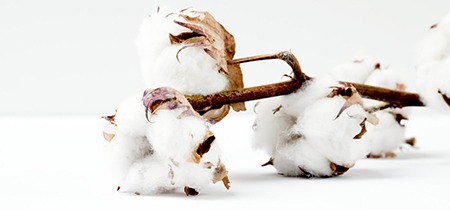
The “fabric of our lives” is used for nearly everything we come in contact with on a daily basis, from our clothes and bedsheets to even some of the food we eat. The growth of conventional cotton can have a huge environmental impact on the use of toxic pesticides and fertilizers. Organic cotton is grown without toxic chemicals and requires less water so the surrounding environmental impact organic cotton farming is much lower.
Any cotton sold as organic in the United States must meet strict governmental regulations. Unfortunately, less than 1% of all cotton grown is organic but today more and more brands are committing to using organic cotton during production; the retailer H&M is the world’s largest buyer of organic cotton.
When looking for an eco-friendly organic cotton option, avoid dyes and go for textiles that come in the natural shades that cotton is grown in, light brown, cream, and pale green. Organic cotton can cost more than conventional cotton due to farming and manufacturing processes but may be worth the extra price to help promote a sustainable and eco-friendly industry.
8. Soybean Fabric
Soybean fabric is a renewable resource as it is made from a by-product of soy foods such as tofu and soybean oil. It has a soft texture comparable to silk when it drapes and can be used for many textiles in the home. It’s also a cruelty-free alternative to silk and cashmere production, which both involve the use of animals.
Soy fabric does undergo an extensive process from a plant into a fabric. This requires breaking down the proteins in the soybean with heat and chemicals which are filtered into fibers and spun into long strands. A positive is that the chemicals in this process are recycled in a closed-loop process, but some can be harmful when exposed to humans.
Soybeans are used in many of the ingredients of the foods we eat today, with nearly 80% coming from GMO (genetically modified) soybeans. How the soybeans are grown can be a factor in it being environmentally friendly or not. GMO soy requires a large amount of water and pesticides for cultivation. If you want a more eco-friendly and sustainable option, look for fabric, garments, or yarn which made from organic soy.
9. Recycled Glass

Recycled glass can be melted down into different forms of glass or glass fiber. When glass bottles arrive in the recycling facility, they are broken and crushed up into tiny pieces, sorted and cleaned, then prepared to be mixed with raw materials like sand, soda ash, and limestone. Combined with these raw materials, glass pieces are melted and molded into new glass bottles and jars.
Glass produced from recycled glass is melted at lower temperatures thus lowering energy requirements for production compared to glass produced directly from raw materials. Recycling glass also reduces the amount of glass waste that will end up in landfills.
Glass from food and beverage containers can are 100% recyclable. Some states in the US even offer a small amount of money, usually .05-10 cents per bottle as an incentive. Be aware that window glass, ovenware, Pyrex, and crystal are produced through a different process so they are not as easily recyclable.
Glass can also be easily upcycled or reused in a creative way. Save your bottles and jars and turn them into reusable storage containers in the kitchen or garage. Some companies are even using recycled glass bottles to create mosaic-style countertops.
10. Recycled Paper
Recycling paper is one of the easiest ways to have a positive impact on the environment. It hasn’t always been popular as the idea of reducing the number of trees felled didn’t catch on until the late 20th century. It wasn’t until 1993 that more paper was recycled than thrown away.
Recycling paper products can have a large impact on the environment as it reduces the amount of “virgin paper” (paper that comes directly from trees) produced. For every ton (907kg) of paper that is recycled, 17 trees are saved. This number is enough to significantly impact the number of greenhouse gases in the atmosphere and keep paper out of our landfills.
It’s worth noting that the recycling process is not perfect. Through the process of processing a raw material like paper, it can have negative effects on the environment.
Most curbside recycling programs allow you to recycle most paper, including newspaper, white office paper, and mixed-color paper. There are many eco-friendly household paper products that are made from recycled paper. Look for these options when next time you are buying toilet paper, paper towels, or napkins. You can also reduce your use and reuse your paper when possible.
11. Recycled Polyester Plastic
PET stands for Polyethylene Terephthalate, which is a plastic resin and a form of polyester. This is identified as #1 PET on the resin identification code (RIC) classification. The number and initials are written inside the recycling symbol with “chasing arrows” and can be found on product labels or directly molded into the plastic.
Most PET plastic containers are used to package food, water, soft drinks, salad dressings, oil, toiletries, and cosmetics. PET is a popular choice for manufacturers because it is a safe, inexpensive, lightweight, durable, and most importantly a recyclable plastic.
After consumption, PET plastic is crushed and shredded into tiny flakes which are then reprocessed to make new PET bottles or packaging. They can also be spun into polyester fiber and made into textiles such as clothing, carpets, bags, and furnishings.
Unfortunately, only 25% of PET bottles in the United States are actually recycled. This number could change in the future with many municipalities offering curbside pickup for recycled plastic readily available. Keep in mind PET plastic cannot be reused and is manufactured with the intent of only single-use.
12. Felt
It’s not just for your children’s arts and crafts projects. Felt is a low-impact, eco-friendly and 100% biodegradable textile.
Wool felt is non-woven and made by condensing and pressing wool fibers together while they are wet. The result is a soft fabric with a fine and dense texture that is often used by artists and craftspeople. Wool felt is also used for its beauty in fashion and is a well-insulating fabric.
Synthetic felt can be made from recycled PET plastic bottles (see above) and turned into furniture or wall paneling with excellent acoustic performance. Felt can also be made into a more rugged and durable material used in construction for roofing or siding on houses.
13. Reclaimed Wool
Reclaimed sheep’s wool is an intelligent technology that is gaining some steam in the fashion industry. During the manufacturing of sheep’s wool products, leftover scraps are collected and recycled. They are first sorted by color, cut into small pieces, and then pulled apart so the fibers can be re-spun into yarn and then weaved into fabric. The result is a fabric that is made from 100% recycled materials.
Reclaimed wool may not be commonplace in the fashion industry yet, but some small brands and manufacturers have taken a step towards sustainability and lowering the environmental impact of wool production.
14. Stainless Steel
Stainless steel is a long-lasting, durable and 100% recyclable material. The average stainless steel object has nearly 60% recycled material and will not contain any potentially harmful chemicals making it food-safe.
Stainless steel can be used for pipes in drinking water systems and is effective against preventing bacteria growth and minimize potential corrosion. In addition to its shine and beauty, it serves as an eco-friendly alternative to many commonly used plastic materials and appliances in the kitchen such as refrigerators, storage containers, bins, and kitchenware.
A very popular alternative for portable food and drink containers, stainless steel products will stand the test of time. Just because the product shines and is metal does not make it stainless steel. Be sure to check with the brand to ensure that it is indeed stainless steel. Most high-quality brands will have the material listed on the product itself. Look for #304 or 18/8 food-grade stainless steel to make sure your product is food-safe.
15. Aluminum
Aluminum is among one of the most eco-friendly and sustainable building materials and the most recycled industrial metal in the world. Often used as a beverage container, the average aluminum beverage can will contain 70% recycled metal and can be reused within 6 weeks from entering a recycling plant.
Aluminum cans are also lightweight and can be stacked to ship efficiently thus lowering carbon emissions through logistics and supply chains. Aluminum cans are produced in a “closed-loop” recycling chain and are infinitely recycled.
When compared to the reusable plastic bottle, an aluminum bottle will be more durable and last much longer. Do your homework and make sure your aluminum bottle has a non-toxic water-based interior coating and is BPA-free to prevent any toxic chemicals from leaching into your beverage.
16. BPA-Free Plastic
By now most are aware of the potential dangers of BPA in plastics. BPA or bisphenol A is a chemical that has been used to make certain hard plastics and resins since the 1960s. BPA is found in polycarbonate plastics and epoxy resins. These polycarbonate plastics are often used in food and beverage containers such as water bottles.
BPA has been linked to potential concerns in children’s health and the environment. Recently, many state governments have taken action restricting the sale of products with BPA. Many consumers are also aware of this potential danger and make the choice for a safer option, therefore, brands have followed suit.
Most companies that produce high-quality products will have “BPA-Free” listed as a feature. Do your research to be sure. Avoid plastics that are marked #3 or #7 according to the resin identification code (RIC) as these have the highest possibility of containing BPA. You can also avoid BPA by switching from plastic to an alternative material such as glass or stainless steel.
17. Recycled Rubber

Did you know rubber can actually be reclaimed and made into sidewalks? Old tires that were once destined to an eternity in the landfill are shredded up and made into paneling that fits together to form a rubber sidewalk. Not only is it softer and feels better under your feet, but when growing trees are near, the rubber will bend and raise around the roots. This prevents any tree removal due to roots tearing up concrete pathways. Reclaimed rubber can also be used for playground surfacing, sports surfaces, and outdoor interlocking floor tiles.
There are two forms of rubber that can be produced, natural and synthetic. Natural rubber is found inside certain plants and is made from a liquid called latex. Synthetic rubber is derived from petroleum and goes through a chemical process during production. Natural rubber is non-toxic and the most eco-friendly option.
Recycling rubber can save energy and ultimately reduce greenhouse gas emissions. Recycling just 4 tires reduces CO2 by about 323 lbs (105 kg), which is equivalent to 18 gallons (68 L) of gasoline. Using recycled rubber in molded products produces a carbon footprint that is 20 times lower than during the production of virgin plastic resins.
18. Reclaimed Wood
Always keep your options open when it comes to purchasing new wood products. Instead of purchasing household items such as flooring and furniture which would be produced from virgin timber, opt for reclaimed wood as an eco-friendly alternative.
This option will save energy, eliminate landfill burning, and reduce timber harvesting keeping more trees on the earth. Old wood can be reclaimed from many sources you may not think of, such as storm-damaged trees, old shipping pallets, unwanted furniture, and razed buildings.
In the past, reclaimed wood was a choice more common for the eco-friendly conscious and those willing to spend money. Now more than ever, individuals with a thrifty and DIY mindset are transforming old wood in a new and creative use bringing some character into your home. Not only will this save your wallet but also give you a sense of accomplishment if you decide to embark on a DIY reclaimed wood project.
19. Clay Brick
Clay brick is all-natural and simply made from water and clay from the earth. It is completely recyclable. Old bricks build new buildings while crushed bricks can pave streets or provide natural mulch to soil. If a brick ends up in a landfill, there is no need for special handling and toxic chemicals will not enter the environment and can be naturally returned to the earth.
Clay brick is energy efficient making it a heating and cooling system’s best friend. It absorbs and releases thermal energy. In the summer, it soaks up the heat keeping a house cooler. In the winter, it traps the internal heat longer to provide warmth.
As one of the oldest materials used by humans, it serves as a durable and reliable building material lasting up to 100 years. Clay brick reduces the need for replacement and other resources needed during construction and has a lower environmental impact during its production compared to metals and other raw materials.
20. Eco-Friendly Paints and Finishes
VOC’s (Volatile Organic Compounds) are extremely hazardous and pose dangers to our health by leaching into the air. They can cause eye, nose and throat irritation, headaches, dizziness, respiratory impairment, and even memory loss.
VOCs are found in many household products including cleaners, paints, and finishes. If you can smell the chemicals present, chances are they contain VOC’s! Be careful about your exposure especially when indoors due to the closed space.
The good news is that many brands are now producing paints and finishes that are low-VOC which are more eco-friendly. They emit a much lighter odor to minimize any irritation. These tend to be water or oil-based paints and contain no chemical solvents and have no emissions during production. Some brands have even developed a paint that is made from milk protein, a super eco-friendly option!
If you plan to paint or finish any DIY projects in your home, go non-toxic and avoid your exposure to VOC’s by choosing an eco-friendly option.
Materials to Avoid
- Non-organic cotton – do you have a piece of clothing labeled 100% cotton? Check again. Your average cotton item may not actually contain what you think. Read labels carefully and look for clothing labeled “organic cotton” with at least 95% of the fibers organically grown.
- Acrylic fabric – this is a synthetic fabric that uses chemicals which according to the EPA, have been linked to causing cancer in animals. Due to these chemicals, it is not biodegradable or recyclable. Not an eco-friendly choice.
- Polyester fabric – virgin polyester production requires crude oil (petroleum) making it a non-renewable resource and giving it a high environmental impact during its production. As a fabric, polyester is reported as a potential irritant to your skin. The only positive is that it can be recycled into PET plastic bottles.
- BPA plastic – as a potentially toxic and harmful chemical and has shown to affect the reproductive system of lab animals. Now the jury is still out on the full effects on humans many choose to avoid BPA altogether. Watch out for plastics that are marked #3 or #7 according to the plastic identification code (PIC) as these have the highest possibility of containing BPA.
Conclusion
These are some of the most eco-friendly materials that you will commonly see different brands marketing as “good” for the environment. Be an educated and proactive consumer. Always do your homework before purchasing to find out how the material or product is manufactured and what exactly is its environmental impact. I hope this guide has been informative and helped you make eco-friendly choices for the future and betterment of our environment.
